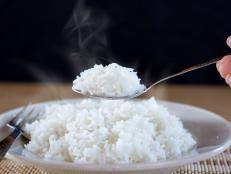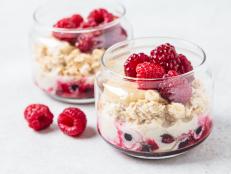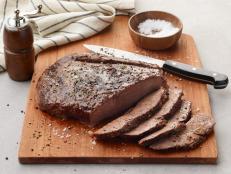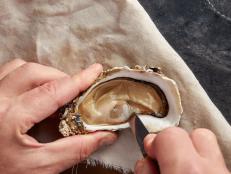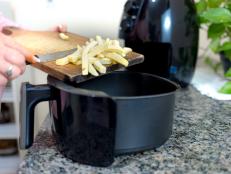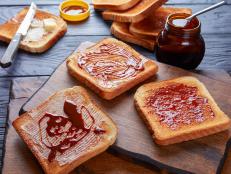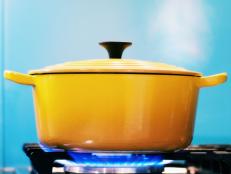You Know You've Wondered: What Happens If You Eat Moldy Food?
Oops, you accidentally ate a moldy raspberry. Now what?

Ian Dyball/Getty Images
By Amy Gorin, MS, RDN for Food Network Kitchen.
Amy Gorin, MS, RDN, is a registered dietitian nutritionist and owner of Master the Media in Stamford, CT.
What Is Mold?
We’ve all heard of mold. But what exactly is it? Mold is a tiny fungus that lives on animals and plants—and can be transported via air, water or bugs, according to the University of Minnesota Extension.
“Because mold is a living thing, it needs water, air and food in the form of organic matter and an ideal temperature of about 60 to 80 degrees Fahrenheit,” says Nicole Stefanow, MS, RDN, a culinary dietitian nutritionist in the New York City area. “Knowing what makes mold thrive can help you keep your family safe from both foodborne and household mold.”
Even though many molds are toxic, some are actually meant to be eaten. “Do you eat Brie or Camembert cheeses with white mold on their surfaces?” asks Sanna Delmonico, MS, RDN, an associate professor at The Culinary Institute of America. “How about Roquefort or Stilton cheeses? These blue cheeses contain Penicillium mold, from which the antibiotic penicillin was derived. These cheese molds are safe to eat and contribute to the unique flavors and textures of the cheeses.” Molds are also used in the production of sake and soy sauce, she adds, and are a part of the same fungi family that mushrooms belong to.
What Happens If I Eat Mold?
Except for the molds that are intentionally parts of food—ahem, blue cheese!—you really don’t want to eat moldy food. The repercussions range from unpleasant and off-tasting food to severe illness that can turn deadly.
“Many molds are categorized as spoilage microorganisms, which means they spoil food and don't make you sick,” says Toby Amidor, MS, RD, author of The Family Immunity Cookbook. “However, some molds can cause allergic reactions and respiratory problems. Other molds can produce poisonous toxins and make you sick.” If you do eat moldy food and feel ill or short of breath, see a doctor immediately.
Additionally, some people are allergic to edible mold present in everyday foods like cured meats and certain cheeses. “If you suspect you have an allergy or sensitivity to mold, it is important to see an allergist who can confirm your allergy,” says Stefanow. “He or she may suggest you avoid some common foods, such as fermented items.”
Can I Cut Off Mold and Eat the Rest of the Food?
In many cases, you can. “You do not have to toss every food that you see mold on into the garbage,” says Amidor. “It actually can lead to a lot of unnecessary food waste.” When you see mold on your food, follow these exact instructions:
- Slice off the moldy portion of the food. “The USDA's Food Safety and Inspection Service recommends that you can cut at least one inch around and below the mold spot for hard cheese like Parmesan and hard produce like potatoes, cabbage and bell peppers,” says Amidor.
- After you’ve sliced off the moldy portion, cover the food with fresh wrapping, such as plastic wrap.
- Compost the moldy portion of the food, if possible.
Note that these instructions apply to hard foods only. “Mold is microscopic, which means what you see is not what you get,” says Stefanow. “Intricate micro-roots are shot down into the food to grab hold. The decision to trim or toss a moldy food comes down to its moisture content. Roots can shoot down deeper in soft, moist foods. Hard, dry foods provide resistance against the roots, which helps to slow growth.”
Stefanow suggests using the following mantra when it comes to mold: When in doubt, throw it out. So if you have a food like yogurt, nut butter, baked goods or fruit that appears moldy, you should go ahead and discard the item.
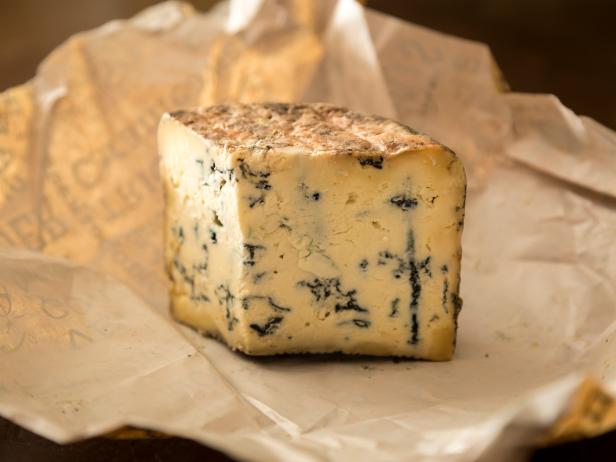
Jon Lovette/Getty Images
Is It Okay to Eat Moldy Cheese?
If the cheese is supposed to contain mold—say, a blue cheese or a Camembert—then it’s definitely okay to eat that cheese. But if a cheese, such as goat cheese, becomes moldy, you should not eat that cheese.
If just a section of a hard cheese, such as Parmesan, is moldy then you can cut off the moldy portion—and at least one inch around and below the mold portion—and eat the rest.
How to Prevent Mold from Forming
Now that we’ve talked about whether or not you can eat mold, let’s take a look at how to prevent mold from forming in the first place.
Follow this mold-prevention checklist:
- Always inspect food—especially breads and fresh produce—before you purchase it.
- Store perishable food in clean containers in the refrigerator, and check that all shelves and drawers are dry. “Damp, warm temperatures are a breeding ground for mold,” says Stefanow.
- Set your refrigerator’s temperature to 40 degrees Fahrenheit or less, advises the FDA.
- Use your fridge’s produce drawers. “They are specially designed to keep fruits and vegetables fresh longer by balancing the humidity in the air,” says Stefanow. “There are two draws for a reason. If you keep fruits and vegetables separate, they should last longer.”
- Clean house when you need to, “When you see mold on one item, that means it is likely that mold spores are other places, too—so it’s time to assess the inventory,” says Stefanow.
- Every two to three months, clean the inside of your refrigerator using a homemade solution of 1 tablespoon baking soda mixed with 1 quart of water, advises Amidor. Rinse with water, and dry.
- Regularly wash and dry dishcloths, sponges, and kitchen towels—as mold can be transferred from these items to food. “If you smell a musty odor, it probably means mold is present,” says Amidor. “Discard and replace anything that cannot be washed or tossed in the laundry.”
- When serving food, keep it covered to prevent exposure from mold spores that may be in the air. When food is not being served, cover it tightly with plastic wrap or a lid.
- Use leftovers within three to four days. This minimizes the time mold has to grow, says Amidor.
- Keep the humidity level in your home below 40 percent, advises the University of Minnesota Extension.
Related Links:


























